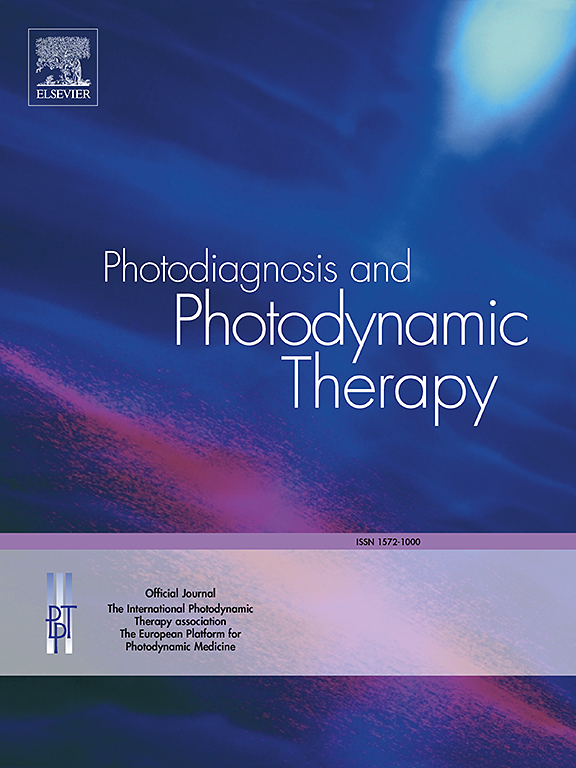Bleaching efficacy of in-office bleaching with violet light using low-concentration hydrogen peroxide nanoparticulate photocatalyst gel: A randomized controlled trial
IF 3.1
3区 医学
Q2 ONCOLOGY
引用次数: 0
Abstract
Objective
This randomized controlled trial aimed to evaluate the bleaching efficacy and tooth sensitivity (TS) of participants submitted to different application protocols of in-office bleaching with violet light using 6 % hydrogen peroxide (HP) nanoparticulate photocatalyst gel.
Materials and methods
Sixty-six participants were randomized and bleached using either a 6 % HP (Nano White, DMC), and/or violet light (Bright Max Whitening, MMOptics), according to the following protocols: 1) only violet light (VIOL); 2) only bleaching gel application (BG) and; 3) combined bleaching gel application + violet light (BG+VIOL). The bleaching efficacy was evaluated with the Vita Easyshade spectrophotometer, Vita Classical and Vita Bleachedguide scales. The risk and intensity of TS were recorded using a 0–10 visual analogue scale (VAS) and a 0–4 numerical scale (NRS). Color change and intensity of TS values were compared using one-way ANOVA and Tukey's test were used. The absolute risk of TS was compared using the Chi-square test (α = 0.05).
Results
A significant and higher degree of bleaching was observed in the BG and BG+VIOL groups compared to the VIOL group (p < 0.003). Despite no significant differences in the risk (p > 0.07) and intensity (p > 0.28) of TS among groups, a higher risk of TS was observed in the BG and BG+VIOL groups.
Conclusions
Using VIOL reduced the risk of TS but did not improve bleaching. However, BG+VIOL with low-concentration HP nanoparticulate photocatalyst gel achieved equal efficacy and was less likely to cause TS compared to BG.
使用低浓度过氧化氢纳米颗粒光触媒凝胶的紫光漂白疗效:随机对照试验。
研究目的本随机对照试验旨在评估使用6%过氧化氢(HP)纳米微粒光触媒凝胶的不同诊室漂白方案的参与者的漂白效果和牙齿敏感性(TS):66名参与者被随机分配,按照以下方案使用6%过氧化氢(Nano White,DMC)和/或紫外线(Bright Max Whitening,MMOptics)进行漂白:1)只使用紫外线(VIOL);2)只使用漂白凝胶(BG);3)联合使用漂白凝胶+紫外线(BG+VIOL)。漂白效果采用伟特 Easyshade 分光光度计、伟特经典和伟特漂白指南量表进行评估。TS 的风险和强度采用 0-10 视觉模拟量表(VAS)和 0-4 数字量表(NRS)进行记录。颜色变化和 TS 强度值的比较采用单因素方差分析和 Tukey's 检验。采用卡方检验(α = 0.05)比较 TS 的绝对风险:结果:与 VIOL 组相比,BG 组和 BG+VIOL 组的白化程度明显更高(p < 0.003)。尽管各组间的 TS 风险(p > 0.07)和强度(p > 0.28)无明显差异,但 BG 组和 BG+VIOL 组的 TS 风险更高:结论:使用 VIOL 可降低 TS 风险,但不能改善漂白效果。然而,与 BG 相比,BG+VIOL 与低浓度 HP 纳米颗粒光触媒凝胶达到了相同的效果,且引起 TS 的可能性更低。
本文章由计算机程序翻译,如有差异,请以英文原文为准。
求助全文
约1分钟内获得全文
求助全文
来源期刊

Photodiagnosis and Photodynamic Therapy
ONCOLOGY-
CiteScore
5.80
自引率
24.20%
发文量
509
审稿时长
50 days
期刊介绍:
Photodiagnosis and Photodynamic Therapy is an international journal for the dissemination of scientific knowledge and clinical developments of Photodiagnosis and Photodynamic Therapy in all medical specialties. The journal publishes original articles, review articles, case presentations, "how-to-do-it" articles, Letters to the Editor, short communications and relevant images with short descriptions. All submitted material is subject to a strict peer-review process.
 求助内容:
求助内容: 应助结果提醒方式:
应助结果提醒方式:


